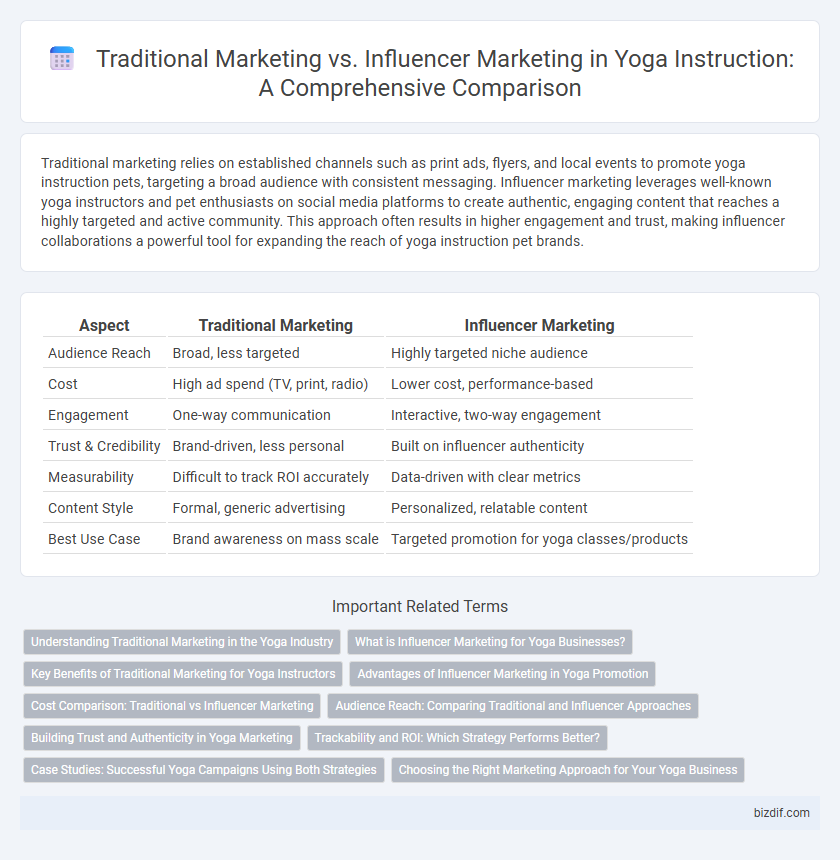Traditional marketing relies on established channels such as print ads, flyers, and local events to promote yoga instruction pets, targeting a broad audience with consistent messaging. Influencer marketing leverages well-known yoga instructors and pet enthusiasts on social media platforms to create authentic, engaging content that reaches a highly targeted and active community. This approach often results in higher engagement and trust, making influencer collaborations a powerful tool for expanding the reach of yoga instruction pet brands.
Table of Comparison
| Aspect | Traditional Marketing | Influencer Marketing |
|---|---|---|
| Audience Reach | Broad, less targeted | Highly targeted niche audience |
| Cost | High ad spend (TV, print, radio) | Lower cost, performance-based |
| Engagement | One-way communication | Interactive, two-way engagement |
| Trust & Credibility | Brand-driven, less personal | Built on influencer authenticity |
| Measurability | Difficult to track ROI accurately | Data-driven with clear metrics |
| Content Style | Formal, generic advertising | Personalized, relatable content |
| Best Use Case | Brand awareness on mass scale | Targeted promotion for yoga classes/products |
Understanding Traditional Marketing in the Yoga Industry
Traditional marketing in the yoga industry involves strategies such as print advertising in wellness magazines, distributing flyers at health fairs, and offering in-studio promotions to attract local clients. These methods rely heavily on building trust through established media and community presence, emphasizing consistency and brand recognition over rapid engagement. While often slower to generate leads than digital tactics, traditional marketing remains essential for fostering long-term relationships and maintaining a credible reputation within the yoga community.
What is Influencer Marketing for Yoga Businesses?
Influencer marketing for yoga businesses involves collaborating with popular yoga practitioners and wellness influencers to promote classes, workshops, and products through their social media platforms. This approach leverages the influencer's trusted relationship with their audience to drive engagement and attract new students organically. Compared to traditional marketing, influencer marketing offers a targeted, authentic way to reach niche yoga communities and build brand credibility online.
Key Benefits of Traditional Marketing for Yoga Instructors
Traditional marketing offers yoga instructors the advantage of local community engagement through physical flyers, posters, and event sponsorships, which foster direct trust and credibility. It allows targeting specific geographical areas, making it easier to attract nearby students for in-person classes and workshops. Consistent branding via traditional channels also builds long-term recognition and reinforces a professional image in the local market.
Advantages of Influencer Marketing in Yoga Promotion
Influencer marketing in yoga promotion leverages authentic personal connections and trust followers have with instructors, resulting in higher engagement and stronger community building compared to traditional marketing. Influencers tailor content to specific niches, such as yoga styles and wellness lifestyles, which enhances targeting precision and brand alignment. This approach often yields increased conversion rates and a more cost-effective strategy for reaching dedicated yoga practitioners worldwide.
Cost Comparison: Traditional vs Influencer Marketing
Traditional marketing for yoga instruction often involves higher upfront costs such as print ads, event sponsorships, and local media buys, which can exceed several thousand dollars monthly. Influencer marketing leverages social media personalities with targeted followings, offering more cost-effective options ranging from sponsored posts to long-term partnerships, typically costing a fraction of traditional methods. Cost efficiency in influencer marketing allows yoga instructors to reach highly engaged audiences with budgets often under $1,000, making it a scalable choice for both emerging and established studios.
Audience Reach: Comparing Traditional and Influencer Approaches
Traditional marketing in yoga instruction relies on local ads, print media, and community events to reach a broad but often generic audience. Influencer marketing leverages social media platforms and trusted yoga personalities to engage highly targeted and active followers passionate about wellness. The influencer approach typically achieves higher engagement rates and more precise audience reach, maximizing conversion potential.
Building Trust and Authenticity in Yoga Marketing
Traditional marketing in yoga relies on established channels like print ads and local events to build trust through consistent branding and professional endorsements. Influencer marketing leverages authentic personal stories and real-time engagement from yoga practitioners, fostering a deeper emotional connection with potential students. Combining both approaches enhances credibility and nurtures a loyal community centered around genuine wellness experiences.
Trackability and ROI: Which Strategy Performs Better?
Traditional marketing in yoga instruction often lacks precise tracking, making ROI measurement challenging due to broad audience targeting and limited data analytics. Influencer marketing provides enhanced trackability through engagement metrics, follower insights, and direct conversion tracking, enabling clearer assessment of campaign performance. Data shows influencer marketing delivers higher ROI in yoga promotion by targeting niche communities with authentic endorsements and measurable user interactions.
Case Studies: Successful Yoga Campaigns Using Both Strategies
Case studies reveal that traditional marketing campaigns for yoga studios, such as print ads and community events, effectively build local brand trust and long-term client relationships. Influencer marketing leverages social media personalities with dedicated followings, driving rapid engagement and enrollment through authentic content and personalized endorsements. Combining both strategies in campaigns, like those by YogaWorks and Alo Yoga, maximizes reach by blending established credibility with viral social proof, resulting in increased class attendance and product sales.
Choosing the Right Marketing Approach for Your Yoga Business
Selecting the appropriate marketing approach for your yoga business hinges on aligning strategies with your target audience and brand goals. Traditional marketing, including print ads and community events, builds local presence and credibility within established networks. Influencer marketing leverages social proof through social media platforms like Instagram and TikTok, driving engagement by collaborating with yoga influencers who resonate with specific demographics and niche wellness communities.
Traditional Marketing vs Influencer Marketing Infographic

 bizdif.com
bizdif.com